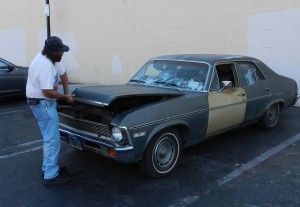
Right after this summer’s breakout of homelessness brought about protests from urban residents, Modesto’s street people were on the move. Pushing and pulling their shopping carts and bike-powered transport systems, they frequented corridors along many of Modesto’s traffic arteries, only to land on a spot where the police would show up and tell them to move on.
Modesto officials soon learned that rousting the homeless from parks and other public places was like trying to clear sand from the desert with a leaf blower. You might move things around for a while, but the dust has to settle somewhere.
Lately, as the homeless have settled back into the parks there’s been a saner effort to adjust to their presence. The police have begun enforcing a benign policy that gives people their rights but keeps drug dealers away.
And though it hasn’t been widely publicized, there was always a strong current of public sympathy for the plight of so many people without a place to go. Those who saw the homeless up close realized that a large percentage of them are seriously disabled in one way or another. While some have hit the streets only recently, others have been homeless for years, many for reasons beyond their control.
As early as the fifteenth century, people realized the need to institutionalize the insane and did so in London’s Bethlem Royal Hospital. The hospital soon acquired the nickname “Bedlam.”
Five hundred years later, authorities in the United States decided we should de-institutionalize the mentally ill. In effect, we moved them outside.
Now, anyone can visit America’s “Bedlam.” Its former patients are on the streets, in the parks, and along the rivers. It’s often said that if you’re not crazy when you become homeless, you soon will be.
Part of the problem is the close quarters with those who suffer mental illness. The simplest transactions and exchanges become elaborate rituals of madness, as do routine errands.
Anyone who’s ever tried to help a crazy person soon learns what it’s really like down the rabbit hole. And even the sanest people can go mad trying to manage without bathrooms, storage places, and transportation while simultaneously dealing with public scorn and contempt.
Something as simple as giving a homeless person a ride to pick up a prescription can turn into an odyssey almost as adventurous as the Greek classic. Many homeless have no identification, no credit, and no access to the restaurants, pharmacies, and retail stores from which they’ve been banned. Their attempts to deal with these barriers range from hilarious to heart-wrenching.
The upshot is a circuitous maze of stops, starts, and detours for the simplest errand. Wasted time and effort are givens. By the end of the day, so little is accomplished it’s no wonder the hole they’re in seems deeper than ever.
Then there are the druggies. By the time a user hits the street, he or she is usually either in need of long-term rehab or beyond recovery altogether. It then becomes anyone’s call whether addiction or mental illness is the real issue.
Homelessness is where family values and professional opinion meet addiction and schizophrenia head on and run whimpering away.
Those few homeless people who retain semblances of sanity and are somehow able to take care of themselves have long since given up on remedies sanctioned by government officials. They’ve tried to make it on their monthly allotments, tried to find jobs, tried social services, prescription drugs, and self-help panaceas, all to no avail.
They will readily agree with those who say homelessness is their own fault. That still leaves them on the merry-go-round of the homeless with nowhere to get off.

I continue to agree with what you have written about our homeless population but I see nothing changing unless the powers that be decide to raise taxes to fund (re-open) state hospitals. You can’t have the milk unless you buy the cow.
Couldn’t agree more Shirley. The anti-tax hysteria of the eighties had some bad consequences and the release of the mentally ill was one of them. Of course, there was also some bad professional judgment involved.
We should be fully funding public health care for all, treatment/support for homeless with a small cut to the military budget or a 2% ussery fee on wall street.
The USA is one of the few 1st world countries that fails this test.
We will need leadership not cheerleaders.